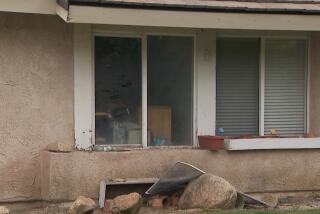Black-and-White, Eaten All Over
It is a cookie with its own cult. Called a black-and-white, it’s a 6-inch-wide, cake-like cookie iced with equal amounts of thick chocolate and vanilla frosting.
New York bakeries, delis and grocery stores sell loads of them. In Southern California they’re harder to find, but that only seems to make them sweeter. When a bakery sells black-and-whites, expatriate New Yorkers flock in, just like at Dodger Stadium when the Mets are in town.
Mickey Jacobs, the 82-year-old owner of J&T; Bread Bin in the Farmers Market, pumps out 15 dozen black-and-whites a day. The Beverlywood Bakery has its own followers. And actor Henry Winkler has been known to place orders for 14-inch custom birthday versions of the cookie at Bea’s Bakery in Tarzana. One employee at West Hollywood’s Dialogue Cafe insists that there are Hollywood agents who buy them a dozen at a time and freeze them to keep clients such as actor Paul Reubens in constant supply.
A Santa Monica couple, professional organizer Ruth Kennison and magazine writer David Hochman, carried their adoration even further. Kennison, who was introduced to them as “half-moon cookies” as a child in Boston, and Hochman, who discovered them as an adult in New York’s Grand Central Station, served them at their wedding. Together, they’re now united in their ongoing search for the ultimate cookie.
What is it about the black-and-white?
No one seems to know where they came from. Jacobs claims the cookie was invented by the kitchen of Austrian Emperor Franz Josef in 1867. Perhaps. One baker at the Beverlywood claimed to know of its origin but grumbled, “I could tell you, but then I’d have to kill you.”
There isn’t even a single standard recipe. The most frequently printed one comes from New York icon Zabar’s, but some black-and-white aficionados find it wanting. It seems that a common problem with black-and-whites is dryness. An impartial taste test of a few Southern California black-and-whites was won by Bea’s Bakery. Bea’s cookie was incredibly moist, just a hint drier than a pound cake, and generously swathed in thick icing. (It is made from a recipe from Cleveland.)
Part of the appeal of the black-and-white is the graphic division between chocolate and vanilla frosting. To some fans, the pleasure is deciding where to take the first bite--a grave philosophical quandary. Some simply divide the cookie in half and take alternate bites from each side. Some munch straight down the center, then sandwich the two halves together to ensure an equal mix of chocolate and vanilla in the last bite.
A writer named Gavin on the foodie Web site Chowhound.com says he and his sister break the cookie in half perpendicular to the dividing line, so each person has half the white and half the black. Together, they then decide where to bite first, making sure each balances the other’s choice with yin-yang precision.
“The key to eating a black-and-white cookie, Elaine, is you want to get some black and some white in each bite,” Jerry Seinfeld once philosophized on his sitcom. “Nothing mixes better than vanilla and chocolate. And yet, still, somehow racial harmony eludes us. If people would only look to the cookie, all our problems would be solved.”
As with any item that develops a following, the black-and-white has its detractors. “Sawdust cakes” is one nickname. And there is the prospect of commercialism. Black-and-white lovers resort to cellophane-wrapped versions only in emergencies (cellophane throws off the cookie’s moisture balance). And under no circumstances should one entertain the thought of eating a cellophane-wrapped black-and-white that has a commercial label.
In fact, Hochman expressed anxiety that interest in the black-and-white could result in its crossing over to trendiness. He admitted worrying that his treasured cookie could become a mass-market item, going the way of the Krispy Kreme doughnut, diluting its multilayered symbolism.
Nothing ruins a cult item like popularity.
Bea’s Bakery, 18450 Clark St., Tarzana. (818) 344-0100.
Beverlywood Bakery, 9128 W. Pico Blvd., Los Angeles. (310) 278-0122.
Dialogue Cafe, 8766 Holloway Drive, West Hollywood. (310) 289-1630.
J&T; Bread Bin, Farmers Market, W. 3rd Street and N. Fairfax Avenue, Los Angeles. (323) 936-0785.
Nahmias is a screenwriter.
*
Zabar’s Black-and-White Cookies
Active Work Time: 45 minutes * Total Preparation Time: 1 hour, 20 minutes
Adapted from “New York Cookbook” by Molly O’Neill (Workman, 1992).
COOKIES
Nonstick cooking spray
1 cup (2 sticks) unsalted butter, softened
1 3/4 cups granulated sugar
4 eggs, room temperature
1 cup milk, room temperature
1/2 teaspoon vanilla extract
1/2 teaspoon lemon extract
2 1/2 cups cake flour
2 1/2 cups all-purpose flour
1 teaspoon baking powder
1/2 teaspoon salt
Heat the oven to 375 degrees. Coat 2 baking sheets with nonstick spray and set aside.
Beat together the butter and sugar in a large mixing bowl until fluffy. Add the eggs, one at a time, beating after each. Add the milk and vanilla and lemon extracts and mix until smooth.
In a medium bowl, combine the cake and all-purpose flours, the baking powder and the salt and stir until mixed. Add the dry ingredients to the wet in batches, mixing well to combine. For each cookie, place 1/4 cup of batter on a baking sheet. Use a knife or offset spatula to shape each cookie into a circle; do not flatten. Space the cookies 2 inches apart.
Bake the cookies until the edges begin to brown, 15 to 17 minutes. Remove to a wire rack to cool completely.
FROSTING
4 cups powdered sugar, sifted
1/4 to 1/3 cup boiling water
2 ounces bittersweet chocolate, chopped
Place the powdered sugar in a large bowl. Gradually add enough of the boiling water, stirring constantly, until the mixture is thick and spreadable.
Remove half of the frosting to a double boiler set over, but not touching, simmering water and add the chocolate. Warm the mixture, stirring, until the chocolate is melted and the frosting is smooth. Remove from the heat.
Turn the cookies to frost the bottoms. Using a knife or offset spatula, coat half of each cookie with chocolate frosting and the other half with white frosting. Repeat until all cookies are done.
About 26 cookies. Each cookie: 306 calories; 79 mg sodium; 52 mg cholesterol; 9 grams fat; 5 grams saturated fat; 53 grams carbohydrates; 4 grams protein; 0.68 gram fiber.
*
Black-and-White Cookies
Active Work Time: 30 minutes * Total Preparation Time: 1 hour, 15 minutes
This is adapted from a recipe that appeared in Long Island Newsday in 1968. It produces a lighter, more cake-like cookie.
Nonstick cooking spray, optional
1 cup sugar
1 1/2 cups plus 1 tablespoon butter-flavored shortening
1/2 teaspoon salt
1 teaspoon light corn syrup
3 eggs
4 cups plus 2 tablespoons cake flour
1 1/2 teaspoons baking powder
2/3 cup cold milk
1 1/2 teaspoons vanilla extract
Zabar’s Black-and-White Cookie Frosting
Heat the oven to 350 degrees. Coat 2 baking sheets with nonstick spray, if using, or line with parchment paper. Set aside.
Cream the sugar, shortening and salt in a mixing bowl. Mix in the corn syrup. Add the eggs one at a time, beating after each. Beat the mixture until light and fluffy.
In a separate bowl, combine the cake flour and baking powder. Add to the egg mixture alternately with the milk. Add the vanilla and blend well.
For each cookie, place 1/4 cup of batter on a baking sheet. Use a knife or offset spatula to shape each cookie into a 4- to 6-inch circle; do not flatten. Space the cookies 2 inches apart.
Bake until light brown around the edges, 18 to 20 minutes. Cool the cookies completely on wire racks.
When cool, frost the cookies according to the instructions in Zabar’s Black-and-White Cookie recipe.
About 22 cookies. Each cookie: 336 calories; 98 mg sodium; 29 mg cholesterol; 14 grams fat; 4 grams saturated fat; 51 grams carbohydrates; 3 grams protein; 0.56 gram fiber.
More to Read
Sign up for The Wild
We’ll help you find the best places to hike, bike and run, as well as the perfect silent spots for meditation and yoga.
You may occasionally receive promotional content from the Los Angeles Times.






